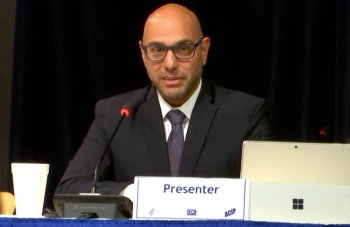
CDC releases updated recommendations for flu season
The intranasal vaccine is back, and changes have been made to the viral composition of this year’s vaccine.
It’s not too early for physicians to start thinking about the flu season-but it may be too early for the vaccine.
Although this year’s vaccine is already available to healthcare providers, it may be best to hold off on vaccination for at least a few more weeks. This and other recommendations are included in the CDC’s annual report on recommendations for flu vaccination. The report also includes updates on the virus coverage and vaccine formulations for this year’s influenza season.
One of the major changes for 2018 included in the report is the update to better-matched circulated viruses, said Kristen Nordlund, a spokesperson for CDC.
The Influenza B/Victoria component was changed, and the Influenza A/H3N2 component was updated in this year’s vaccine. The viruses included in this year’s trivalent vaccines are:
- an A/Michigan/45/2015 (H1N1) pdm09–like virus,
- an A/Singapore/INFIMH-16-0019/2016 (H3N2)-like virus, and
- a B/Colorado/06/2017–like virus (Victoria lineage).
Quadrivalent vaccines will contain these three viruses plus an influenza B vaccine virus, a B/Phuket/3073/2013–like virus (Yamagata lineage), according to the CDC.
The CDC continues to recommend vaccination for all individuals over the age of six months of age without contraindications, noting that egg allergies are no longer a contraindication for vaccination. The report stated that any individual with an egg allergy “may receive any licensed, recommended, and age-appropriate influenza vaccine (IIV, RIV4, or LAIV4).”
There are also some changes this year to vaccine availability, with age extensions recently added to Afluria Quadrivalent-previously recommended for patients aged 18 and up but now approved by the U.S. Food and Drug Administration for anyone over 5 years of age.
An expanded age range was also approved for Fluarix Quadrivalent (IIV4), previously approved for ages 3 and up, but now approved for use in anyone over 6 months of age, according to the report. This vaccine can also be given in the same dosage-0.5 mL-for children aged 6- to 35-months as well as adults.
In other news, the intranasal formulation of the flu vaccine- FluMist Quadrivalent-is making a return to the market. The intranasal vaccine, an LAIV4, was unavailable from the 2016 season until now over concerns that it was particularly ineffective against certain flu strains. Changes were made to the vaccine, and CDC is reinstating its recommendation for the vaccine for anyone aged 2 to 49 years of age.
The American Academy of Pediatrics, however, is reserving its recommendation for use of FluMist Quadrivalent as an alternative only, stating that it would prefer to see more updated efficacy data before generally recommending the intranasal vaccine again for all children.
Nordlund added that all recombinant vaccines this year will be quadrivalent, with no trivalent vaccines available this flu season, and that cell-grown flu vaccines will all be quadrivalent, as well.
“For this vaccine, the influenza A(H3N2) and both influenza B reference viruses will be cell-derived, and the influenza A(H1N1) will be egg-derived,” Nordlund said. “All these reference viruses will be grown in cells to produce the components of Flucelvax.”
Although intradermal vaccines for the flu are being studied, Nordlund said there are no intradermal vaccines approved for use this year.
Speaking on availability of the vaccine, Nordlund said supply depends on the private manufacturers who make the vaccines, but they have predicted that they would provide between 163 million and 168 million doses of the vaccine for this flu season.
As for timing, the CDC recommends vaccination by the end of the October, although variability in peak times for influenza activity prevent the agency from making a specific recommendation on optimal vaccination timing. Concerns for waning immunity as the season progresses, resulting in suboptimal coverage by peak flu activity-usually in January or February-deserve some consideration, although the report noted that waiting too long to administer vaccines could result in decreased interest and missed opportunities.
The report suggested that vaccination is most effective when given later than July or August, but before community flu activity begins and definitely by late October. Missing this window isn’t a reason to give up, though. The report noted that even late vaccination can offer some coverage, particularly when flu activity persists into the spring months.
Newsletter
Stay informed and empowered with Medical Economics enewsletter, delivering expert insights, financial strategies, practice management tips and technology trends — tailored for today’s physicians.








